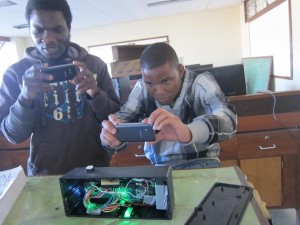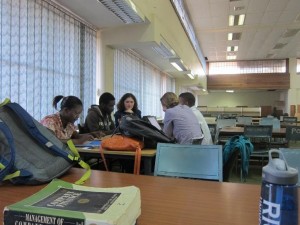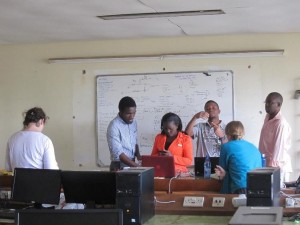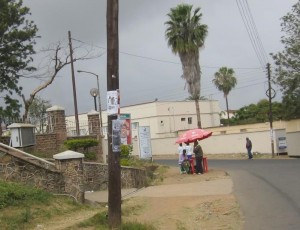Acquiring cell phones here was extraordinarily easy. We popped into a store located a ten minute walk from the Poly, and quickly obtained phones, chargers, and minutes all for 5,500MKW, or $12.22. Though we chose to buy the simplest phones, only capable of calling and texting (used for communication between the interns), there were also smart phones readily available for purchase. Users of all cell phones buy minutes and bandwidth on the street, from vendors who set up at small tables on almost every corner in downtown Blantyre. The entire process is run by immediate consumer need—users buy only the minutes they want, when they want them—which makes it adaptable. There are no formal bonds committing cell phone users to one supplier, and there are no wasted minutes nor wasted bites. Within Blantyre, access to the internet—and access to its world of information—through common cell phones is pretty widespread.
Internet access and cell phone usage across Africa has shot up in the past decade. Though both of these systems are still centered largely in the urban cities, they are beginning to penetrate further into rural areas. Like all expanding infrastructure, extending the digital network will take time, resources, and restructuring. However the speed that our technical abilities have grown to me indicates a promising near future in which the internet can be accessed at least by some in most areas of the world.
Even at Rice, there is currently research focused on, classes offered about, and programs aimed towards creating clever ways to expand internet access into low-resource areas. Discovering methods to reduce necessary additional physical infrastructure in order to drive down the price of internet while maintaining quality is an area of research where I see electrical engineering overlapping with the potential to improve global health.
Of course, in some instances, there is no feasible digital substitute for an in-person, trained doctor. In the ideal future, there may be an adequate number of capable health care workers to work on-site with patients; as it stands, however, the ratio of doctor to patient in much of Africa is far less than this ideal:
As a result, for every one physician in Zimbabwe there are 6,300 patients, and in Cambia, 9,300. In Ethiopia it’s 45,400 patients per physician, and in Liberia, it’s 71,400 to one. There are only 120 doctors and 100 nurses for the 11.3 million residents of South Sudan. (1)
Stable internet and a framework through which district hospitals and smaller health-care centers can interact with larger hospitals may provide a trusted channel for rural healthcare workers to communicate questions to and glean advice from specialized doctors in the city centers. While not ideal, such interactions may improve education and health care practices in the interim. There is also opportunity for increased efficiency. Trainings and updates that can be communicated over the web prevent excess time and resources from being spent. A quote from Wired magazine conceptualizes this potential:
Wires warp cyberspace in the same way wormholes warp physical space: the two points at opposite ends of a wire are, for informational purposes, the same point, even if they are on opposite sides of the planet. The cyberspace-warping power of wires, therefore, changes the geometry of the world of commerce and politics and ideas that we live in. (1)
Once this network is made accessible, interacting with it is quick and easy—just like our experience buying cell phones here. Supplying the internet is the hard part of this equation, but once present people of vastly varying ages and education levels will be capable of benefitting from it. The project of expanding Wi-Fi is incredibly complex, and is something that long-term (after much more schooling) I may look into pursuing. For the time being, though, we as interns can at least begin thinking about the various ways in which we can take advantage of this expanding network.
- New devices for digital healthcare. For internet-enabled-healthcare to be feasible, current health technologies and practices have to be reimagined. For pictures and videos to transmit information from a patient to a physically distant doctor, we must find alternative ways to communicate accurate information about attributes such as size and color of objects that, in person, are taken at face value. This is a problem that a recent Rice global health team tackled. In Barretos, a cancer hospital has nurses take photos of patient skin lesions across southern Brazil, then send these photos in to the central hospital. A doctor then evaluates these photos to determine if the patient should make the trip to the hospital for further evaluation. The device is a physical attachment to cell phones which improves color and size interpretation, as well as photo clarity. Two Rice BTB interns are in Barretos this summer, rolling out the new technology—if you are curious and want to learn more, check out Pablo or Megh’s blog!
- Development of communication channels. I wrote a post about the importance of collaboration before, and access to Wi-Fi facilitates the development of these relationships. Looking forward in this internship, one of the projects we hope to pursue is creating a system to connect Polytechnic students with Rice students; this connection has the potential to benefit both academic growth as well as device success. Almost any two institutions involved in my global health experience so far could benefit from increased communication, resulting in rising rates of both efficiency and efficacy.
- Preventative maintenance. During our tour of PAM last week, we noticed many of the devices suffered a malfunction caused by user error. Considering the array of machines that fills hospital wards, it isn’t surprising that small user mistakes are frequent. Even more frequent is forgotten technology maintenance: some devices require a new filter every 2 months, while other devices require lubrication every week, still others require water to be kept at a steady level throughout use, and others require constant monitoring for overflow. The intricacies of every device can get overwhelming even for maintenance engineers, and far more so for busy nurses who have patients to attend to. Sometimes, simple check-ins with the trained employees at PAM could prevent major device breakdown. However, as I’ve mentioned before, PAM does not have the funding to visit various district hospitals for preventative maintenance needs. There are many possibilities that can be explored to decrease device misuse/overuse by establishing a live connection between engineers and the smaller healthcare centers. For example, technology-specific overview videos could be created to remind nurses of common user interface problems and required maintenance needs; training updates for new practices could be conducted over the web, or forums created for common questions. All of these channels would need to be streamlined and organized, however they again provide the potential for increased efficiency and efficacy.
Of course, the expansion of internet has far greater implications than just healthcare, and the adoption of these new, Wi-Fi enabled technologies may meet some huge barriers. Users would need to adapt to a new method of communicating and working, as computer technology brings in its own learning curve that could slow progress. However, since internet usage rates are already on the rise, a new market full of largely untapped possibilities is coming regardless; it only makes sense to begin reconsidering past solutions to present problems.




(1) Olopade, Dayo. The Bright Continent: Breaking Rules and Making Change in Modern Africa. N.p.: First Mariner, 2015. Print.